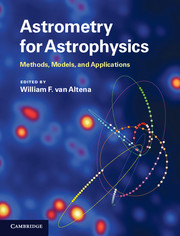Book contents
- Frontmatter
- Contents
- List of contributors
- List of acronyms
- Preface
- Part I Astrometry in the twenty-first century
- Part II Foundations of astrometry and celestial mechanics
- Part III Observing through the atmosphere
- Part IV From detected photons to the celestial sphere
- 13 Geometrical optics and astrometry
- 14 CCD imaging detectors
- 15 Using CCDs in the time-delay integration mode
- 16 Statistical astrometry
- 17 Analyzing poorly sampled images: HST imaging astrometry
- 18 Image deconvolution
- 19 From measures to celestial coordinates
- 20 Astrometric catalogs: concept, history, and necessity
- 21 Trigonometric parallaxes
- Part V Applications of astrometry to topics in astrophysics
- Index
- References
14 - CCD imaging detectors
from Part IV - From detected photons to the celestial sphere
Published online by Cambridge University Press: 05 December 2012
- Frontmatter
- Contents
- List of contributors
- List of acronyms
- Preface
- Part I Astrometry in the twenty-first century
- Part II Foundations of astrometry and celestial mechanics
- Part III Observing through the atmosphere
- Part IV From detected photons to the celestial sphere
- 13 Geometrical optics and astrometry
- 14 CCD imaging detectors
- 15 Using CCDs in the time-delay integration mode
- 16 Statistical astrometry
- 17 Analyzing poorly sampled images: HST imaging astrometry
- 18 Image deconvolution
- 19 From measures to celestial coordinates
- 20 Astrometric catalogs: concept, history, and necessity
- 21 Trigonometric parallaxes
- Part V Applications of astrometry to topics in astrophysics
- Index
- References
Summary
Introduction
Charge-coupled devices (CCDs), the standard imagers at all observatories today, consist of integrated circuits made through the same process as computer memory or the chips in cell phones. Complementary metal oxide semiconductors (CMOS) are an alternative image-sensor technology with high noise immunity and low static power consumption; however, CCDs are the dominant imagers today, so we will concentrate our discussion on their use.
Silicon crystals are sensitive to light through the process by which incident photons of sufficient energy can excite electrons into the valence levels of the atom. Photons with energies less than the valence levels fail to create photoelectrons and are therefore not detected, while the higher-energy photons are absorbed near the surface of the silicon layer before creating usable photoelectrons. If one applies a voltage to the silicon in a controlled manner, these photoelectrons can be either held in place (during the integration) or moved through the silicon lattice (during readout) and collected.
What is a charge-coupled device?
When a CCD is constructed, a square grid of microscopic electrodes called gates is fabricated on the surface of a silicon wafer (see Fig. 14.1). The orthogonal axes of the grid are called columns and rows and the grid elements are the pixels, which have typical sizes of 10–20 üm. When exposed to optical light, the silicon substrate reacts to each absorbed photon by creating one photoelectron–hole pair. The gate voltages control the movement and position of these photoelectrons.
- Type
- Chapter
- Information
- Astrometry for AstrophysicsMethods, Models, and Applications, pp. 222 - 234Publisher: Cambridge University PressPrint publication year: 2012



